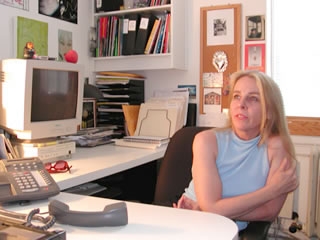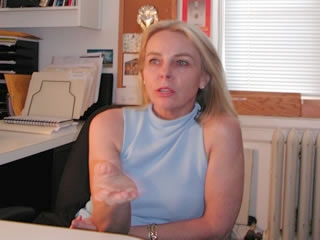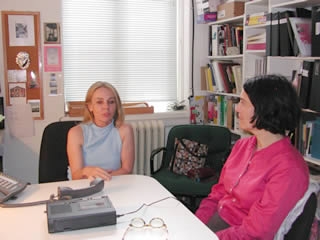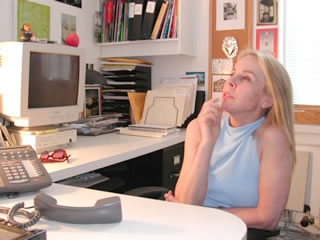Feature: Conversations
Libby Lumpkin
Last August, some of the Stretcher crew sat down with artist Margaret Crane and art historian Libby Lumpkin to discuss the art world, feminism, theory and theorists and pop culture.
Margaret Crane is an interdisciplinary artist, writer and educator. Since 1984, she has been part of the collaborative team Margaret Crane|Jon Winet. The collaboration’s work includes multi-media gallery installations, public art, video, web-based projects, public events and publications.
Libby Lumpkin was the founding curator of Stephen Wynn’s Bellagio Gallery of Fine Art, at the Bellagio Resort in Las Vegas. She has edited and produced a collection of theoretical essays, titled Deep Design: Nine Little Art Histories and has a forthcoming book on Los Angeles artist Ingrid Calame. She was a contributing editor of Art Issues magazine and is a regular contributor to Artforum. She is now the Assistant Professor of Modern Art and Assistant Curator of the Donna Beam Gallery of Fine Art at the University of Nevada Las Vegas.
Maragret Crane Libby, I think of you as someone that looks at both high culture and pop culture with the same kind of attention. I’m really curious — do you watch television?
Libby Lumpkin Oh yeah, I do. I usually take little breaks all day long, so I really get a full spectrum of TV because I flip through and have something like 41 channels. Just to get off my feet I’ll lay down on my bed, turn on the TV and start flipping until I’m ready to get up again. So yeah, I see a lot of TV actually. Do you watch TV?
MC I go through phases. I haven’t lately, but I love doing that very thing.
LL I mean the invention of the flipper has just changed the whole perception of the world. It’s such an amazing thing.
MC Sometimes channel surfing is a very important part of my life. What do you like?
LL I like All My Children. I’ve been keeping up with them for some time. When I was in graduate school in Art History at the University of Texas my colleagues got me hooked on All My Children and I keep up with it. And I watch the news, I’m a news junkie…
MC I’m really interested in soap operas myself because I think of them as the fantastic elaborate narratives that extend over decades. I know you have some thoughts about narrative and art.
LL I think that we’re really dominated these days with narrative art — what I call "image art". In other words, Freudian and Marxist readings try to put everything in historical perspective or in perspective of the psyche. It requires a narrative to do that and I think that that’s why abstract art has been marginalized until recently — it’s certainly back in a big way now. It doesn’t provide an easy narrative. People had a problem of reading only the narratives in works of art and not seeing anything but the narrative. They ignored form and thereby ignored a great deal of the meaning of the work itself because form and narrative equally makes meaning.
FINE VS POPULAR ART
MC It strikes me that popular culture is becoming more and more infused with what we would call traditional narrative — like All My Children — while the art world is looking once again at formalism. How do you think these two concepts coexist in the culture?
LL I think that there is a movement lately to collapse the distinction between the popular arts and the fine arts. Recently, museums, like the Guggenheim and the Met, have wished to elevate the popular arts so that they’re the same as the fine arts — posing, for example, the Harley Davidson as Modernist sculpture. The confusing part is that you have a lot of art that can look very much like the art of popular design and visa versa so you really can’t distinguish on general appearance or theme issues. Ultimately you have to make that generic divide based on audience.
MC So, how do you define different audiences? What distinguishes them?
LL If you start talking about audience and this idea of the divide, and if you divide according to audience then you typically want to characterize the audience. For example, you don’t want to characterize the audience that comes to Las Vegas as middle American and generally uneducated to the higher arts or to characterize the fine art audience as sophisticated people, when in fact there are all types of people in both audiences. And so…you can’t divide on the character of the audience — you can only divide on size and taste. So Las Vegas is designed to appeal to the broadest possible audience. It wants to be all-inclusive and in the attempt to do that its design exploits conventions.
MC Conventions…like narrative conventions…
LL In the last ten years we have virtually a grand tour on this new Las Vegas strip with Egypt and Italy and ancient Rome and Venice and Paris with the Eiffel Tower and the Arc de Triomphe. The reason that I think those types of things occur is because they’re well-worn conventions. When you’re trying to appeal to the broadest popular audience, you want those conventions. The design principal of Las Vegas is very simple: take the most conventional tropes they can imagine and then "spectacularize" them. Fine art is different — not because its audiences are better, or smarter, or more sophisticated — it’s that they have a taste for art that puts them in unfamiliar circumstances. In other words, they want the complexity of encountering an object that perhaps they can’t at first understand or perhaps they want to confront an object that presents them with a new way of looking at the world. Not everyone in the world has a taste for looking at these types of objects.
MC I think we are in a time now where boundaries are certainly blurring between traditionally held ideas about high art and popular art.
LL People think that Las Vegas, for example, or motorcycles and the Guggenheim have just become fashionable in the last years, but artists have been coming to Vegas and looking at popular culture and stealing from it since, gosh, at least Pop.
MC So, even though audience members bring different ideas about complexity to the work…the boundaries betrween high and pop culture remain?
LL I’m not sure that I think the audience brings it, I think the art brings it out in the audience. Some audiences like to have challenges and others don’t. Others like their challenges in other ways. Everybody’s got an area of complexity. I know many people that have no interest in popular art and they will go out and spend hours and hours understanding a woofer. They like their complexity in other areas. It’s just this idea that somehow the fine art audience is a better group of people, or that fine art design is better in terms of a value system in our culture and I don’t agree with that. I don’t think fine art makes you a better person, I think all it does is entertain. Different audiences like to be entertained in different ways. I like this comedian, you like that comedian, you like that kind of humor, I like this kind of humor.
ANTI SPECTACLE
MC Going back to narrative — one of the ways you use the term narrative is to talk about a kind of familiar and well-worn set of assumptions that can allow people to have an easy experience.
LL I think that when you come predisposed to match up a work of art to your theory then you’re going to read that narrative into the artwork. It’s a little bit like Freud analyzing you. He almost always puts you into some grand narrative, puts you at the center of some Sophoclean play from which he developed his theories and that’s certainly a wonderful place to be. In other words, with Freudian analysis you have drama, not theater.
MC Right, the family drama.
LL And because Freud really developed some wonderful and very engrossing ones that (with the help of people like Sophocles) are classics because they really touch us. And then therapy is so inviting because you get to put yourself into those high dramas and that’s a very pleasing thing for people to do.
MC In a sense, perceived or received information, like Freudian tropes, can allow you to miss what’s actually happening.
LL I think a lot of people missed what was happening. I think you have some artists who have been terribly marginalized that were doing great work, but the critical community just didn’t recognize what they were doing. David Reed being one, Lari Pitman being another whose work has had a huge effect among artists. But it was a long and slow time coming for them to get the widespread critical attention because most of the critics were being trained in these discourses that had nothing to do with looking at works of art. They were looking through the works of art to find a familiar narrative and to then suggest that narrative means what it means — and I mean that the artwork means the narrative that they find there. I think it prevented them from learning anything from art. I’m constantly amazed at how much I learn from artists and their vision of the world.
MC What are some of the things that you’ve learned?
LL I see more and more art that is relinquishing the very idea of authority. We’ve had the whole 80’s deconstructing all kinds of authorities and our culture. But you see somebody simple like Mutti & Rosenblum or Tim Gardiner lately, or Elizabeth Peyton, who makes work that’s not light-hearted, but light conversation. It’s like "oh here’s what I want to look at" and "here I’m just this ordinary person — there’s no drama in my life — this is what I want to look at ." But they don’t try to teach you anything. They don’t try to solve problems in the world. They just try to get through the day. I mean most of us, let’s just admit it, we’re ordinary. We’re just regular middle-class creatures and there’s not a lot of drama and yet we want to go make art.
MC It’s the opposite of the spectacle.
LL Absolutely the opposite of the spectacle. And this is another thing — Las Vegas has been so voguish for ten years and more and more artists are borrowing the attributes of Las Vegas entertainment design and employing them in various ways in their works of art. I’m afraid it looks like to me that we’ve gone too far in this direction and in the assumption that the attributes of visual pleasure in your work will actually be pleasurable. And there is no connection there — not in fine art — if you employ conventional attributes of visual pleasure in the popular arts, generally it works, but not in fine art, not where you want to be surprised. You want to encounter the unfamiliar and enjoy the exercise of unraveling why it is you’re compelled to look at something you don’t understand.
MC You’re describing the pleasures of complexity, but you also write about the surface of things. Tell me about surface.
LL There’s a cognitive therapist named Aaron Baker who has the most wonderful quote that I love to steal, he said, ìThere’s more to the surface than meets the eye.î We’ve had this presumption that there’s depth in paintings — this comes from the Freudian analysis of works of art, but what I see now is that what really matters in a work of art is on the surface - because it is, of course, on the surface. And anytime you’re trying to find depth — when you look at anything and you see the whole history of patriarchy and you read this grand narrative of abuse and vindication or whatever narratives you want — you’re imposing this kind of depth in the work without really looking at the surface of it.
Also I think we had this whole generation of art that was about the idea of desire as a theme, but wasn’t embodying desire itself. So now we’re seeing these very luxurious surfaces and textures and other ways to seduce and entice and intrigue the eye. So that’s one way that we’re moving closer to the surface.
MC I think a lot of work about desire in the ‘80s wasn’t sexy.
LL Right. I think we’re moving toward a more pragmatic tradition now. In fact, I’d go back to Mutti & Rosenblum and Tim Gardner and these other artists who are expressing their desires, even Kara Walker — she is going to show you her fantasies. In other words, what they’re doing is resisting temptation for themselves to be read, or for their art to be read, in the Freudian, early childhood development depth kind of reading. They’re just working through things one day at a time — "this is what I want to look at and this is a very surface thing." In other words, problems are staying on the conscious level and not in some metaphysical unconscious that no one can ever really understand.
MC So it sounds like you’re describing work — and I don’t think this is conscious on the part of the artist — that resists or that repels some projection by the viewer.
LL I think if you make work that inspires the desire of the viewer then that can be more interesting — something that certainly Bernini figured out is what you could do with just surface, this kind of seductive smoother…
WORDS
MC I think that nowadays the word "art" is way too small for what many artists are doing. I think there’s a lot of ways in which art branches into technology and design and politics and journalism and science. I think using the word "art" becomes really confining.
LL I think just the opposite. I think the word "art’ has become much too broad. I think in the whole history of modern art there has been absolutely no change in the rules of how you make art. I think art has changed how it looks and its various ideologies have changed in every other way except the fundamental aspects of art, which is it must entertain. And it has to entertain that art audience that respects and looks for complexity, challenge and adventure and unfamiliarity. And that’s why a lot of that politically correct art of the ‘80s played itself out because the whole art world is like a cocktail party and works of art are like these bits of conversation. Now if somebody comes up to you and says ‘I really think we should do something to help save the rain forest,’ well you know, I agree, I’m for the rain forest, too, but you’re preaching to the converted. So art has got to do more than that — it’s got to either present some new information in a new way or it could present you old information in a new way.
MC I do think the idea of being a feminist has changed over the past 30 years. For me, I find that certainly it’s a word that maybe should either get a new meaning or there should maybe be some different word also. As a critic, I’m curious how you would position yourself in regard to feminism?
LL What happened to the word "feminist" was that it was taken over by academic feminists who had these misguided ideas about the virtue of women. And the ordinary woman is not any more virtuous than most men. I think they captured the word feminist and corrupted it into this fascist idea about political correctness and in addition saw heterosexual sex as bad — any kind of desire or the statement of it or public courtship rituals they presumed to be the cause of the oppression of women. So all of these young women coming on line with their hormones in full gear — as they always are — associated feminism with these academic feminists.
I actually have many young women who would tell me about their politics which were perfectly feminist politics, but would say ‘I would never be a "feminist"’ because what that came to associate with was comfortable shoes.
MC So given what you just said, would you be willing to characterize yourself as a feminist?
LL Oh absolutely, I am a feminist. I am not just a feminist, I am the best, biggest, baddest most radical feminist you’ll ever meet — I promise you, there is no one more feminist than me. There are a lot of people who think they are, but they are not. Trust me, because I want women to win, and I’ll tell you, the most you can get out of any academic feminist is "well, I think we should all be equal" — I don’t think so, I think we should kick butt and take names.
MC That’s a good use of the word feminism…
Meredith Tromble As we were looking at your lecture last night, at the picture of Mutti and Rosenblum, there was a portrait that had under it a sentence that was something like ‘guilt, by showing us what we shouldn’t do, tells us about what we want’. As I recall you said something like, ‘that captures part of what I’m talking about — about the problem with the ‘80s.’ But that statement is from a position of the people who were in power already, and there is still a power structure in place which doesn’t include a lot of people of color or anything like equal representation of women.
LL But what happened, I think, was generally with the guilt came this oppression of the very idea of desire. Kara Walker said "I want complete freedom to draw on my imagination and my fantasy life and to make any kind of image I want to" and I think without question, Kara has become the most important black artist probably that is. Certainly there are great ones — Martin Puryear, for example — but as far as being a radical and being on the forefront of a movement and really changing the discourse and her works having enormous consequence in the world, she’s become very important. And she did this by telling us how her desire is structured. What you have to do is take a powerful position and put your desire out there.
MC ...and other artists who take powerful positions?
LL In her own small way, Elizabeth Peyton is drawing these wan men that she’s obviously obsessed with. They’re so beautiful and that whole idea is embodied in the way they’re rendered. We see that more and more and that’s what I think we should have been seeing instead of tying ropes around dolls and hanging them as if trying to punish evil capitalism. Let’s talk to women about what they want. In other words, let your desires simply shoulder out the other ones. They will if they’re powerful enough, like Kara’s and Elizabeth’s. They shouldered out and they’re two of the most important artists in the world right now.
ICONS
MC The world that is becoming increasingly post-literate. In your book Deep Design you look at icons and symbols. Do we rely on them more now than in the recent past?
LL I do see a symbol-based world and actually it’s just that our culture here in America is so diverse, we have many people that don’t read English and we have so many nationalities that it’s just simpler. They hire these people in these burger joints and they have pictures on the cash registers. I don’t think we’ll ever be without the words because they tried that earlier in the the 1920’s and 30’s — to create an international sign system when air travel made it possible to move around to other places. People were driving into each other in foreign countries and not knowing where the bathroom was. So Margaret Mead and a bunch of other people thought it would be really great if we just had this international sign system and many other groups did too and there was a big push to do it. Very few of them have survived — the prohibition symbol being one of them. I did a lot of studies on those when I was doing that book on the prohibition symbol and you know they’re perfectly reasonable — little people for this, half a person for that — the little mountain with the rocks falling down. That’s very effective, but that’s not like an icon that (becomes) caught in the imagination and become a substitute for words.
THEORY THEORY
MC in the interview in "Eye Magazine" the (San Francisco Art Institute magazine), you spoke about theories of practice. What do you mean by that?
LL Well, as far as I can tell, there are no theories of practice, not since the American pragmatists tried to develop one. I’m not sure that practice needs a theory. I don’t care how theoretical the academy wants to be, it’s never been anything else and I’m a part of that. But they were stuck in a certain brand of theory and considered their brand of theory to be theory itself and that any challenging type of theory was not theory, it was ignorance of their theories or anti-theoretical.
MC What brand of theory are you thinking of?
LL There’s…the hegemony of the conceptualist style in art. So what I’ve seen happen is that artists stopped thinking of art as a practice and considered themselves as intellectuals and you see that particularly in art school. But what has happened is that the conceptualist style had come to be associated with intelligence — with the thinking artist. It became a signifier. And after 30 years of hegemony it wasn’t even thoughtful, it was stupid, and the thinking artist had to go and do something else. So that was my point — art is a practice, it’s not a type of art. We had the French academy in the late 17th Century — they had their academy and famous, (which I think gave rise to the term) academic argument — between the Reubenists and Poussinists, between color and line — because the artists that advocated line felt that was a more conducive way to put down an idea in a painting. That line itself became associated with idea and since Louis the XIV wanted to enhance the idea of the liberal arts in France at that time to enhance his regime and make it look like an enlightened, liberal machine, he wanted this art. So they associated the signifier line as something associated with ideas and history and the things that French painting at that time was supposed to do. Color they saw, rightly, associated with sensual bodily responses, and they didn’t necessarily want that associated with the regime.
That is exactly the place we found ourselves in the 80’s, in which you had this style — conceptualism is just a style and all art has been conceptual, it never was any other way — a style that denigrated the physical aspects of works of art and privileged the non-sensual aspects. It was just a replay of the Reubenist and Poussinist argument. So I wasn’t ever suggesting that artists shouldn’t think — they have to think — but there’s different ways of thinking. In art you’ve got to think with your hands or your camera or whatever you’re gonna do. It’s a practice, if you don’t make the piece, nobody gives a damn what’s in your head.
MC I think something that happens again and again in the art world is people resist the academy and what was at one point a thrilling new way of perceiving the world for artists and for people looking at the work becomes entrenched. Once that happens, it loses its effect.
LL Art schools are the most contradictory places. It’s so difficult because since art can look like anything, we don’t even know what the next art is going to look like, and you have a situation in which you’re trying to teach students to make something and you don’t have a clue what it looks like. That’s why art schools tend to be so stressful for people, I think it’s stressful for the faculty and for the student because nobody knows what it is going to look like. There aren’t any practical rules, there are some fundamental rules you can learn about the nature of your practice and if you go outside of those rules, then you’re probably not going to get anywhere.
LOVIN’ LOVE
Ella Delaney I had a question about the practice of art history. You’re talking about the practice of art-making as an art historian — which has its own history and practice — but it’s based on the practice of another area, another method. I’m interested in how they converge. Is one based on the practice of looking at it and talking about it and the other based on the practice of actually doing it?
LL Well you always do that I think — so you’re always having a new reaction to old things always, otherwise how could you have 45,762 books on Cezanne? Because everyone keeps going back, there’s something there for me. Now, what Cezanne means today is vastly different from what he meant then, but he still means something and usually you can’t really know the Cezanne without knowing some of the history. Even if all you know is that he was part of the Impressionist movement, that becomes a treasure. When you look at a Cezanne today, you know you have part of the moment when artists did something so radical it changed things that have lasted till today. It changed the nature of the practice, it changed the way we see the world and it changed the way everybody made paintings. In fact it’s very much like that in Vegas — the strip is so conservative in its entertainment venues that it’s a little bit like a museum when you go see Liza Minnelli or Debbie Reynolds. It’s like you’re entertained by virtue of being in this party that’s celebrating the memory of having been entertained by these people. It’s always a little bit like that when you’re encountering an older work of art too.
MC I like that thought of Debbie Reynolds being part of the museum on the strip of faded entertainers.
LL Some of the sweetest moments you’ll ever have are to sit in those audiences, because, let me tell you, if you can feel love, the love is in the air, it’s palpable.
MC Don’t get me wrong, I’m a big Debbie Reynolds fan.
LL I just love lovin’ people.





